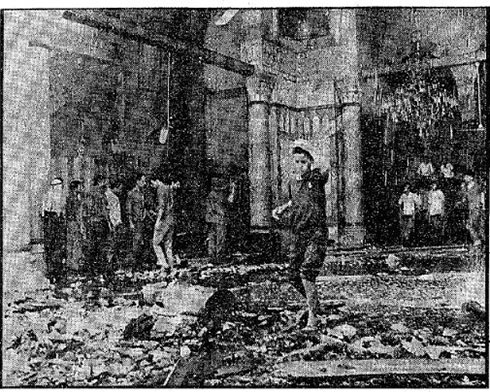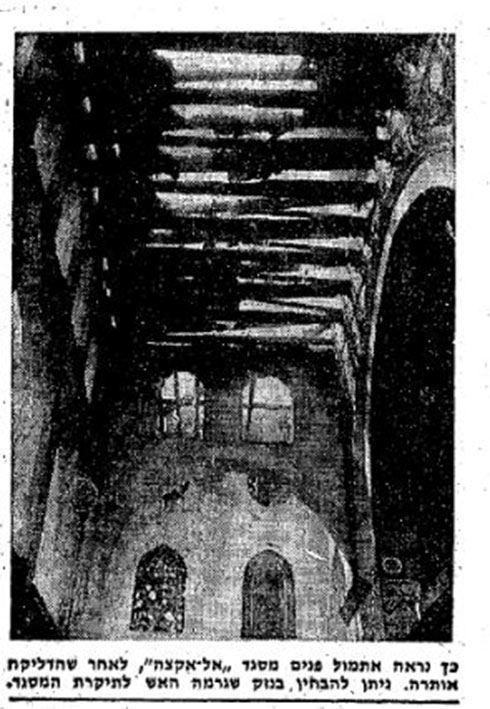
The fire in Al Aqsa
46 years ago on this day, an Australian tourist suffering from severe mental illness, managed to enter the Al Aqsa mosque compound undeterred, set fire to the mosque's stage, and fled the scene. The mosque quickly caught fire and incurred serious damage. Muslim worshippers immediately blamed the Jewish population, and soon there after clashes broke out in Jerusalem. The Australian tourist, Denis Michael Rohan, said that god had asked him to set fire to the mosque, saying he would be made a "king of Jerusalem."
On the 21st of August 1969, at 7:20 AM a group of Muslim worshippers were making their way to the Al Aqsa mosque. The man responsible for temple security was among them, wearing a khaki uniform, standing at the entrance to the compound. Suddenly the calm was broken: A young man ran out of the mosque yelling "fire, fire."
A group of men who were on their way to prayers ran into the mosque, and within minutes managed to remove as much as they could grab: carpets, dividers, prayer books, and furniture. In the meanwhile, a plume of black smoke billowed above the golden dome. The smoke emanating from one of Islam's holiest sites was clearly visible from all over Jerusalem.
In a matter of minutes, hundreds of the old city's Muslim residents, including many children and teens, arrived at the temple mount. The masses of people began yelling and screaming, and whether intentional or not, interfered with the firefighters attempts to control the flames. The crowd managed to shut off the fire truck's water hoses. One individual went as far as breaking the only fire hydrant on the temple mount.
In a matter of minutes the six Jerusalem based fire trucks exhausted their water supplies, with the lack of immediate water sources at hand, the crews were forced to cease fighting the fires for a matter of time. As a result, the fire spread towards other wooden areas within the mosque.
Soon after the fire began spreading, the screams of the masses of Muslim worshippers reached a fever pitch, with some of the youths yelling curses against the "Jews who burned our shrine," while others yelled "Arab Palestine." At 8:30 AM a thunderous sound was heard from within the mosque, followed by a rising black cloud of smoke. A large portion of the wooden roof had collapsed as a result of the fire, falling onto the mosque floor. The crash led to yet another wave of hysterical screaming, as it was described, followed by a wave of pushing and violent outbursts.
The fury reached its peak when then Jerusalem mayor, Teddy Kollek entered the burning mosque. Police officers rushed to protect him from any possible injury, but where quickly repelled by the angry crowd, who began raising their fists to ward off the officers. Furious Muslim youths also managed to push high ranking military officials from the temple mount. The officers chose to not to push into the mount, preferring to leave through the Mugrahbi Bridge, and avoid sparking another outbreak of violence. Kollek followed the officers in leaving the compound. One of the officers barely managed to escape the wrath of an angry woman, who raised her shoe above her head, intending to hit the officer.
The firefighters finally managed to subdue the fire at 10 AM. Tensions among the Muslim population however, where not subdued, as dozens of youths began running towards the Damascus gate, clutching wood planks and iron beams. The police did not want the situation to devolve and quickly dispersed the youths by firing warning shots in the air.
About an hour after the fire was put out, then Defense Minister Moshe Dayan arrived at the scene. Later that afternoon, Prime Minister Golda Meir and her deputy Igal Alon arrived on the scene as well. Meir entered the mosque with her head bowed, and with sorrow hanging heavy on her face. Upon exiting, Meir said the arson would not affect relations between Jews and Arabs.
Sheikh Helmi Muhtaseb, Chairman of the Islamic Committee of Jerusalem, spoke to the journalists who escorted Meir into the mosque, saying that the fire was not started by a power cord shorting, but by targeted arson: "The guards noticed a suspicious figure walking around the mount in the early morning hours, who later escaped mere minutes before the fire erupted. The guards chased him, but were not able to catch him. We have an exact description of his face. We are sure he is not Palestinian. We demand an international commission of inquiry be established, including Arab engineers."
Al Muhtaseb, called for the closure of the Mugrahbim Bridge, and the closing of the mount to non-Muslims. Concurrently, 27 Muslim countries called on the UN Security Council to hold an urgent session on the matter of the arson.
In the meanwhile, the Israeli police aired the possibility that the attack was perpetuated by a terrorist organization in an attempt to fan the flames against Israel. The responsibility for checking into the terrorism angel was placed squarely on the shoulders of the security forces. At the same time, a committee of inquiry led by Supreme Court justice Dr. Yoel Zussman was established in order to investigate the arson.
On Friday night at 8:00 PM, 36 hours after the arson, the police held a special press conference in which the chief of the southern district police, deputy commissioner Shaul Rozilio said that a 27-year-old Australian named Denis William Rohan was behind the arson.
Deputy Commissioner Rozilio said: "The suspect is in our custody, he belongs to a small Christian cult named the 'Lords church.' The suspect arrived from Australia as a tourist four months ago." His friends said at the time that he was a really quiet person: closed off, who besides work and torah study; which he attended frequently, did not fit into society. His friends who asked him about his unusual lifestyle where usually met with the answer that no one could understand him because of his membership in a special messianic cult.
Rohan's interrogation revealed that he had previously attempted to burn down Al-Aqsa two weeks prior to the arson, but failed. In his first attempt he shoved a plastic hose under the mosque door and poured gasoline through the hose, hoping that the door and the mosque would catch fire. His plan was not successful, as the fire never caught, and he fled the area, only returning on August 21st.
A guard had attempted to prevent Rohan from entering the mosque that same day, however Rohan offered the guard "drinking money" and the Australian tourist was let in. Upon entering the mosque he realized it was empty, lest a woman, Rohan believed had not noticed him. Rohan took advantage of the moment and set fire to the Salah A' Din stage. The fire quickly spread to the rest of the mosque, and the suspect fled.
Rohan was captured largely due to the memory of the mosque guard. The police drew up sketches of suspects and showed them to the guards, who picked him out of the bunch. Rohan arrest a week prior to the incident for a fight, landed him in the booklet. During the investigation, Rohan said that the mosque was "interfering with the coming of Christ and the messiah." An announcement was made soon after, stating that his trial would be held in a Jerusalem municipal court. But a suggestion was made to hold the trial in a larger venue, so journalists from all over the world could cover it. Five days after the arson, Rohan was brought back to the mosque to reenact the crime.
A month after the incident, the investigative commission declared that the arson was committed by one man, and damaged the third holiest site in Islam while fanning tensions with the whole Arab world. The committee pointed to poor security procedure on behalf of the Islamic Whakf. It was additionally made apparent that a mosque worker saw the Australian in the mosque, however did not approach him, even though tourists are banned from entering the mosque in the early morning hours.
The committee additionally said that the choice by police to not use force during the riots following the arson was justified. "Although the firefighters risked their lives, the use of force may have caused a bloodbath, and the police chose the lesser evil. They made the right choice."
During his trail Rohan said that god wanted him to build the new temple, and that he was set to become the king of Jerusalem. "Yep, I lit the fire in the Al-Aqsa mosque. I am a descendant of the family of king David, and the queen of England is a relative of mine." He stated that he received a "sign from god" which told him to burn the mosque.
Rohan was later indicted for the crimes he was charged with; however the justices declared that he was not responsible for his actions. They cited his psychotic and indoctrinated state in their decision. "Fire became an important element in his life. He lived a life of suffering, isolation, and repression. We saw a man who truly believed what he was saying," the ruled.
After the judgment was read, he was handcuffed and sent to a psychiatric facility. After a few years he was expelled back to Australia, where he was placed in psychiatric care upon his arrival, and until his death on the 6th of October 1995.



















